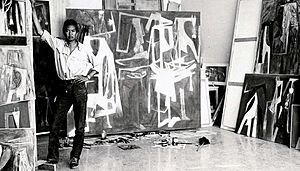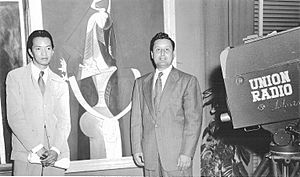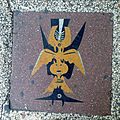Wifredo Lam facts for kids
Quick facts for kids
Wifredo Lam
|
|
|---|---|
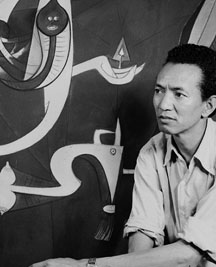
Wifredo Lam
(José Gómez-Sicre photographic archives) |
|
| Born |
Wifredo Óscar de la Concepción Lam y Castilla
December 8, 1902 Sagua La Grande, Cuba
|
| Died | September 11, 1982 (aged 79) Paris, France
|
| Known for | Painting |
|
Notable work
|
The Jungle (1943), Museum of Modern Art collection. |
| Spouse(s) | Eva Piriz (1929–1931; her death) Helena Holzer (1944–1950) Lou Laurin (1960–1982; his death, 3 sons) |
| Awards | Guggenheim International Award |
Wifredo Lam (born Wifredo Óscar de la Concepción Lam y Castilla; December 8, 1902 – September 11, 1982) was a famous Cuban artist. He wanted to show and bring back the strong spirit and culture of Afro-Cubans. He was inspired by and worked with some of the greatest artists of his time, like Pablo Picasso, Henri Matisse, Frida Kahlo, and Diego Rivera.
Lam mixed these ideas to create his own special style. This style is known for its unique "hybrid figures" – creatures that are part human, part animal, and part plant. His art style still inspires many artists today. While he was mostly a painter, he also made sculptures, pottery, and prints later in his life.
Contents
Early Life and Art Beginnings
Wifredo Lam was born and grew up in Sagua La Grande, a small village in Cuba. His family had a mixed background. His mother's family had African roots (from Congo) and Cuban roots. His father was a Chinese immigrant. In Sagua La Grande, Lam was surrounded by many people of African descent. His family, like many others, practiced Catholicism along with their African traditions.
Through his godmother, Matonica Wilson, who was a Santería priestess and healer, he learned about the rituals of African spirits called orishas. Even though Lam never officially joined Santería or other similar groups, he knew a lot about their practices. This was because these traditions were very common in Cuba. His experiences with African celebrations and spiritual practices became his biggest influence as an artist.
In 1916, Lam moved to Havana to study law, which his family wanted him to do. At the same time, he also started studying tropical plants at the Botanical Gardens. From 1918 to 1923, Lam studied painting at the Escuela de Bellas Artes. But he didn't like the traditional way art was taught or painted there. In 1923, he left for Madrid, Spain, to continue his art studies.
Art Career in Europe
In 1923, Lam began studying art in Madrid. He learned from Fernando Álvarez de Sotomayor y Zaragoza, who was a curator at the Museo del Prado. In the mornings, Lam went to his teacher's traditional studio. But in the evenings, he worked with younger, more modern painters. At the Prado museum, he was amazed by the works of Hieronymus Bosch and Pieter Bruegel I.
Lam's early paintings were in the Spanish modern style. But his work soon became simpler and more decorative. Even though he still didn't like old-fashioned art rules, his time in Spain helped him develop his skills. He started to combine a raw, natural look with Western painting styles. Later, in Paris, Lam learned about African sculpture. In 1929, he married Eva Piriz. Sadly, both she and their young son passed away in 1931. This personal tragedy likely made his art darker.
New Influences and War
During the 1930s, Lam was influenced by many art styles, including Surrealism and the work of Henri Matisse. He had already started using Surrealist ideas before coming to Europe. He learned about artists like Matisse from magazines and friends. As Lam traveled through the Spanish countryside, he felt a connection with the Spanish farmers. Their struggles reminded him of the former slaves he grew up around in Cuba.
When the Spanish Civil War started in 1936, he supported the Republicans. He used his art skills to create posters and messages for them. Lam was called to defend Madrid, but he was injured in late 1937 and sent to Barcelona. There, he met Helena Holzer and the artist Manolo Hugué. Manolo gave Lam a letter that helped him become friends with Pablo Picasso. Picasso's art had already impressed Lam a year earlier.
In 1938, Lam moved to Paris. Picasso quickly supported him and introduced him to many important artists, like Fernand Léger, Henri Matisse, Georges Braque, and Joan Miró. That same year, Lam visited Mexico and stayed with Frida Kahlo and Diego Rivera.
Picasso also introduced Lam to Pierre Loeb, an art dealer in Paris. Loeb gave Lam his first art show at the Galerie Pierre Loeb in 1939. Critics loved it. Picasso and Lam also showed their art together in New York that same year. Lam's art changed from showing Matisse's influence (in his still lifes and portraits) to being influenced by Cubism. He mostly used gouache (a type of paint) and started painting figures that looked like Picasso's work. Many of his 1938 paintings were very emotional. They showed couples or sad women and had a much stronger African influence, seen in the sharp lines and combined body shapes.
Lam had started simplifying his forms before meeting Picasso. But it's clear Picasso had a big impact on him. Lam said Picasso's exhibition was "not only a revelation, but… a shock." Picasso's encouragement helped Lam find his own unique way of painting modern art.
When World War II started and the Germans invaded Paris, Lam left for Marseille, France, in 1940. There, he met up with many thinkers and artists, including the Surrealists, whom he had known since meeting André Breton in 1939. In Marseille, Lam and Breton worked together on Breton's poem Fata Morgana, which Lam illustrated. In 1941, Breton, Lam, and Claude Lévi-Strauss, along with others, tried to leave for Martinique but were imprisoned. After 40 days, Lam was released and allowed to go to Cuba, arriving in mid-1941.
Return to Havana and New Art Style
When Lam returned to Havana, he became more aware of Afro-Cuban traditions. He saw that the descendants of slaves were still treated unfairly. He also noticed that Afro-Cuban culture was being changed and made into something simple for tourists. He believed Cuba was losing its African heritage. So, he wanted to help free this culture from being controlled and misunderstood.
His time in Cuba also led to a quick change in his art style. Using his studies of tropical plants and his knowledge of Afro-Cuban culture, his paintings began to feature hybrid figures. These figures were part human, part animal, and part plant. His style was also special because it mixed Surrealist and Cubist ideas with images and symbols from Santería.
In 1943, he started his most famous work, The Jungle. This painting showed his mature style, with four figures that had mask-like heads, appearing from thick tropical plants. Later that year, it was shown in an exhibition in New York and caused a lot of discussion. The painting showed the tension between modern art and the lively energy of African culture. The Jungle was bought by the Museum of Modern Art in New York. It is often compared to Picasso's Guernica.
Another painting by Picasso that has been compared to The Jungle is Les Demoiselles d’Avignon. Even though these two paintings were made 36 years apart and have different cultural backgrounds, they both show women and use early art (primitivist) and Cubist elements in their designs.
Lam's mix of African ideas with a European style in The Jungle led to some difficulties. Lam and his second wife faced discrimination from some people in Cuba. After returning to Cuba, Lam moved away from the main art community and tried more with Cuban modern art styles. Some Cuban artists even questioned if Lam was truly Cuban in his art and identity. Scholar Fransisco J. Hernández Adrían says Lam felt rejected by artists in his own country because of his race. However, Adrían argues that Lam's blend of art elements from different cultures helped connect thinkers in Cuba with liberal thinkers around the world.
Lam continued to simplify his abstract art but still painted figures. He also kept developing the stories and symbols that defined his style. In 1944, he married Helena Holzer, but they divorced in 1950. In 1946, he and Breton spent four months in Haiti. There, Lam learned even more about African spirits and magic rituals by watching Voodoun ceremonies. However, he later said that his contact with African spirituality in the Americas did not directly change his painting style. African poetry, though, was said to have broadened his paintings. In 1950, he worked with René Portocarrero and others on pottery in a village called Santiago de Las Vegas. Lam settled in Paris in 1952, after spending time between Cuba, New York, and France.
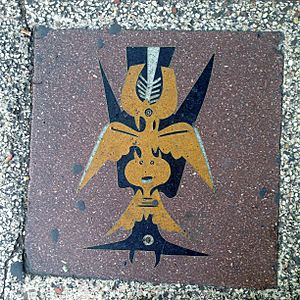
Lam always supported ordinary people. In 1955, he showed a series of paintings at Havana University to support students protesting against Batista's government. Similarly, in 1965, six years after the revolution, he showed his loyalty to Castro and his goals of fairness for everyone. He painted El Tercer Mundo (The Third World) for the presidential palace.
In 1960, Lam opened a studio in Albissola Marina, Italy. He settled there with his wife Lou Laurin, a Swedish painter, and their three sons. In 1964, he won the Guggenheim International Award. Between 1966 and 1967, many shows of his work were held across Europe. Encouraged by Asger Jorn and interested in local pottery, Lam started experimenting with ceramics. His first ceramic show was in 1975. In his later years, he also made sculptures and cast them in metal. These often showed figures similar to those he painted.
Wifredo Lam passed away on September 11, 1982, in Paris, at 79 years old. He had more than 100 personal exhibitions around the world, so he was very well-known by the time he died.
Wifredo Lam's Artistic Legacy
Wifredo Lam, like many famous artists of the 20th century, combined modern art styles with traditional arts from the Americas. While artists like Diego Rivera and Joaquín Torres García were inspired by Pre-Columbian art, Lam was influenced by the Afro-Cubans of his time. He skillfully blended Surrealist and Cubist techniques with the images and spirit of Afro-Cuban religion. Because of this, his work doesn't fit into just one art movement.
He believed that society focused too much on individuals. He wanted his art to show humanity as a whole. He painted general figures to create a universal message. To help with this, he often painted faces that looked like African tribal masks. While Cuban culture and stories filled his work, his art also explored the nature of humans. This made it easy for people from all over the world to relate to his art.
The Wifredo Lam Center for Contemporary Art (Centro de Arte Contemporáneo Wifredo Lam) opened in 1983 in Havana, Cuba. It's a government-run gallery honoring Lam. This art gallery organizes the Bienal de la Habana, a big art event in Cuba. It also has a collection of about 1000 artworks and studies modern visual arts from developing countries.
In 2015, a large exhibition of his works opened in Paris at the Centre Georges Pompidou. It then traveled to the Reina Sofia Museum in Spain and the Tate Museum in London.
The Jungle Painting
The Jungle is considered Lam's most important painting. It perfectly shows his mature art style. The painting features "polymorphism," which means it combines parts of humans, animals, and plants. This creates strange, hybrid creatures. This mixing of forms is like a magical change. Some experts think these figures came from Lam's subconscious mind, linking the artwork to Surrealist ideas. The crowded way the painting is put together can make it feel a bit closed-in, and the shapes are hard to tell apart. Experts believe this abstract way of building figures comes from the Cubist art style.
What You See in The Jungle
The four figures in the painting have long, undefined limbs. Their large feet are especially emphasized. You can also see African-inspired mask-like heads. Experts say Lam was very interested in the carvings on African masks. The shimmering quality of the forms makes the painting feel even more tropical.
The idea of the tropics is also shown by the tightly packed sugarcane stalks and palm leaves that blend with the figures. This reflects ideas from Afro-Cuban religions, where gods live inside elements of nature. The sugarcane in the painting might represent the fields where African slaves worked for the Spanish and Portuguese. The figure on the far right holding shears is thought to be harvesting sugarcane. The figure on the far left looks like a horse and might represent a character from Afro-Cuban stories. Even though the sugarcane gives some clues, there's no specific place where The Jungle is supposed to be. Experts suggest this lack of a specific location makes the artwork appeal to a wider audience.
The dark colors, a mix of blue, green, yellow, and white, suggest a hidden scene lit by the moon. This might refer to the secret practice of African religions among enslaved people. The colors in The Jungle could also show a daytime scene deep inside a jungle. Some historians also suggest that the red and orange colors in the painting represent blood.
The Meaning of The Jungle
The Jungle was not meant to show Cuba as primitive or undeveloped. Instead, Lam wanted to show a spiritual state, inspired by Santería. He wanted to highlight how absurd it was that Afro-Cuban culture was being simplified and cheapened for tourism. Specifically, scholar Adrían suggests that The Jungle criticizes the way the Atlantic region was viewed after the colonial era. Lam wanted to show the real experiences of Afro-Cubans at that time, and he became famous for doing so. The artwork is believed to have challenged the colonial way of thinking. Adrían also claims that the images in the artwork reflect the constant struggles black people faced in Cuban society. One of the main struggles shown is the slave labor suggested by the sugarcane in The Jungle. Art historian Doris Maria-Reina Bravo argues that the hard work many people had to do in Cuba, as shown in the artwork, was very different from how tourists saw Cuba. She says that when the artwork was made, tourists saw Cuba as a "playground."
Artworks by Wifredo Lam
- Deux personnages. 1938.
- Mother and Child. 1939.
- Anamu. 1942.
- Satan. 1942.
- The Jungle. 1943.
- Untitled. 1943.
- Homenaje a jicotea. around 1943.
- Untitled. 1945.
- Le guerrier. 1947.
- Le Reve. 1947.
- Exodo. 1948.
- L'Espirit aveugle. 1948.
- Lisamona. 1950.
- Les enfants sans âme. 1964.
- El Tercer Mundo. 1965–1966.
- The Shadow of Days. 1970.
Images for kids
-
Salón de Mayo, 1967. Sidewalk insert in front of the Radiocentro CMQ Building by Wifredo Lam.
See also
 In Spanish: Wifredo Lam para niños
In Spanish: Wifredo Lam para niños
- Cuban art


